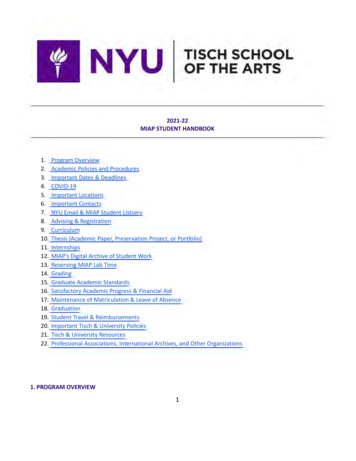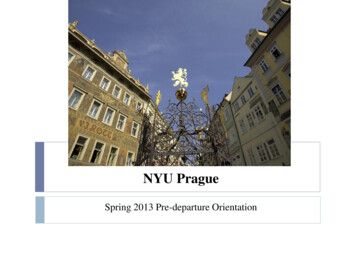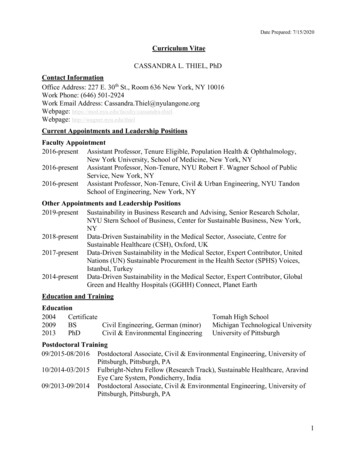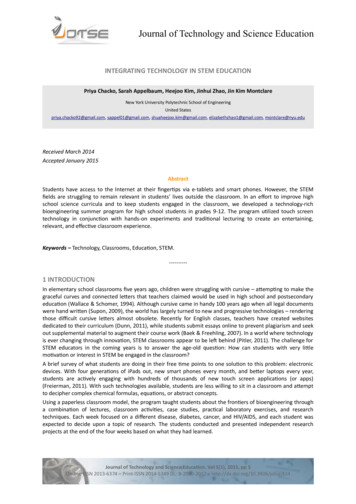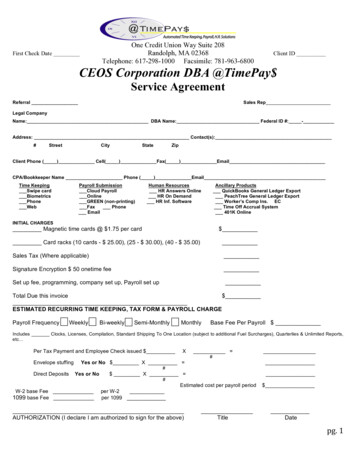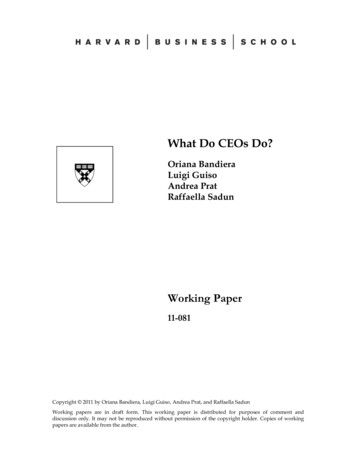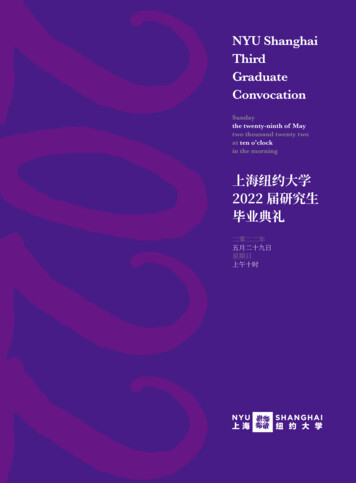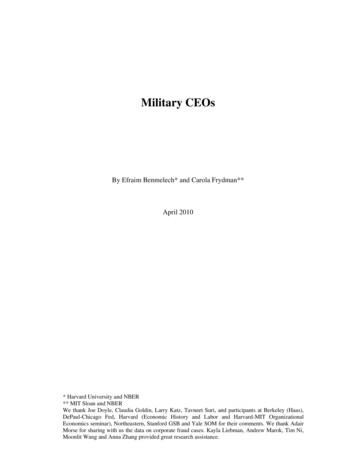
Transcription
Military CEOsBy Efraim Benmelech* and Carola Frydman**April 2010* Harvard University and NBER** MIT Sloan and NBERWe thank Joe Doyle, Claudia Goldin, Larry Katz, Tavneet Suri, and participants at Berkeley (Haas),DePaul-Chicago Fed, Harvard (Economic History and Labor and Harvard-MIT OrganizationalEconomics seminar), Northeastern, Stanford GSB and Yale SOM for their comments. We thank AdairMorse for sharing with us the data on corporate fraud cases. Kayla Liebman, Andrew Marok, Tim Ni,Moonlit Wang and Anna Zhang provided great research assistance.
AbstractWe analyze the effect of military service of CEOs on a host of managerial decisions,corporate policies and outcomes. Exploiting exogenous variation in the propensity toserve in the military that is driven by year of birth, we show that service in the militaryleads to lower corporate investment in both capital and R&D. Our evidence also suggeststhat CEOs who serve in the military are less likely to be involved in corporate fraudulentactivity and perform better during industry downturns. Taken together, our results showthat service in the military has a causal effect on managerial decisions and firm outcomes.Given the steady decline in CEOs with military background since the 1980s, firms with ademand for these particular skills may face a real challenge in obtaining optimalmanagerial talent.1
“I don’t know what I’d be doing (without the military), but I wouldn’t be here. A daydoesn’t go by that I don’t use the leadership lessons I learned in the Navy. It wasabsolutely vital.”Anthony F. Early, Jr., CEO DTE Energy1. IntroductionCEOs with military backgrounds have been disappearing from Corporate America. Thesupply of executives who served in the military and, in particular, those with combatexperience has been diminishing in the last two decades as World War II and Koreaveterans began to retire. While 59% of the CEOs of large publicly-held corporations in1980 had served in the military, only 8% of these firms are now run by CEOs withmilitary background. Instead, most current chief executives have been trained throughbusiness degrees and executive education.1Does military background matter forcorporate decisions and performance?Service in the military may matter for CEO performance for several reasons. First,militaries have organized and sequential training programs combining both educationaland on-the-job experience that are designed to build and develop leadership andcommand skills. Thus, individuals may acquire hands-on leadership through serving inthe military that it is difficult to teach otherwise, being better in taking decisions underpressure or in a crisis situation. Furthermore, many of the CEOs who served in themilitary were in fact officers and as such they were trained to hold high levels ofresponsibility and authority even at low levels of commands. Finally, military service is1The fraction of CEOs with a business degree has increased sharply over this period. In fact, only 15.8%of the CEOs in 1980 had an MBA degree. This ratio was a much higher 39.1% by 2006.2
based on duty, dedication and even self-sacrifice, as such the military may provide avalue system that can encourage the CEO to make ethical decisions, be more dedicatedand loyal to the companies they run, even if the actions are difficult and unpopular.2On the other hand, the military is often perceived as an institution where membersmostly follow orders and, even among those individuals in charge of giving orders, maynot encourage the development of interpersonal skills that are essential in the businessworld. In this paper we analyze empirically the effect of military service on managerialdecisions and corporate outcomes.Our paper is related to a growing literature in corporate finance that hasemphasized the importance of the person in charge of an organization for firm’s decisionsand performance (Graham and Narasimhan 2004, Malmendier and Tate 2005, PerezGonzalez 2006, Bennedsen, Nielsen, Perez-Gonzalez and Wolfenson 2007, Schoar 2007,Kaplan, Klebanov and Sorensen 2008, Bennedsen, Perez-Gonzalez and Wolfenson 2008,Malmendier, Tate and Yan 2010). Likewise, Bertrand and Schoar (2003) show that topexecutives have person-specific managerial styles that contribute to the differences inperformance, financial and organizational policies across firms. Understanding whichexperiences and individual traits shape these managerial fixed effects remains an openquestion. This paper explores the possibility that particular experiences in the life of aCEO help shape the type of manager he will become by focusing on whether chiefexecutives with a military background behave differently than their non-military peers.We start our analysis by studying the relationship between military experienceand a host of corporate decisions and outcomes. We find that firms run by military CEOs2See the Korn-Ferry International (2006) report for a more detailed exposition of these arguments.3
invest less and have lower expenditures on research and development. However, we findno effect on financial policies, accounting measures of performance, and valuation.An important observation is that the managers in our sample spend on averageless than four years in the military. Thus, the effects documented in the paper areunlikely to be driven by career officers that are later hired because of their high rankingand connections. In fact, only a handful of the executives for whom we observe thelength of their military service stayed in the military for 10 or more years.While we would like to interpret our finding as evidence for a causal effect ofservice in the military on executive decisions, our analysis is prone to an omittedvariables problem. For example, it is possible that we are capturing unobserved personalcharacteristics correlated both with service in the military and corporate policies. Inorder to address this selection effect and to show that military service leaves an imprint infuture CEOs, we use an instrumental variable strategy. Our approach exploits the fact thatthe likelihood of serving in the military is higher for some cohorts due to high demand formanpower during wars. Since managerial styles of individuals born in earlier cohortsmay be different from those of younger CEOs (Bertrand and Schoar 2003, Malmendierand Nagel 2007), we also include flexible controls for CEO age in our regressions.As an alternative strategy, we compare individuals with a high likelihood of beingdrafted because they turned 18 years of age at the height of World War II and the KoreanWars with those less likely to serve since they became of eligible age immediately afterthe wars ended. Results from both approaches overall validate our finding of a negativeeffect of military service on investment and R&D expenditures.4
The instrumental variables approach suggests that simply sorting into militaryservice due to unobserved innate characteristics does not drive our findings. However,another concern is that firms experiencing a decline in investment opportunities hiremilitary CEOs for reasons we do not observed which are not captured by the battery ofcontrols we employ in our regressions. We address this concern in several ways. First, wecontrol for industry fixed-effects in all of our specifications and thus our results areunlikely to be driven by specific trends in industries that are also more likely to hireCEOs who served in the military. In fact, we do not observe any pattern in the types ofindustries that hire CEOs with military background. Moreover, we analyze whether theprobability of hiring a military CEO depends on firm outcomes in the years prior to thehiring decision. The probability of hiring a CEO with military experience is in fact lowerin those firms that have had lower levels of investment and R&D relative to the industrymean in the years prior to the CEO succession. In summary, military CEOs do not seemto be selected into particular industries or into firms that have already adopted a strategyof reduced investment.While our results seem consistent with a causal effect of military experience onCEOs’ decisions, there are two possible channels through which military experience mayaffect firm outcomes.First, firms with a need to reduce investment and R&Dexpenditures may choose to hire a chief executive with military experience for thispurpose. Alternatively, military background may not be part of the selection criteria inchoosing a CEO. Under this scenario, the imprinting of military service exogenouslyaffects executive decisions and as a consequence is reflected in corporate policies. Whilewe cannot differentiate between these two interpretations, both of these mechanisms are5
consistent with a causal effect of military experience on firm outcomes whether by amatching mechanism or through random assignments.Finally, we flesh out potential mechanisms through which military experienceaffect CEOs’ behavior. Specifically, we consider the effect of military background onCEO performance under pressure. We find that CEOs with military background tend toperform better during periods of industry distress as evident by higher market-to-bookratio. Most interestingly, we also find that military CEOs are significantly less likely tobe involved in corporate fraudulent activity compared to CEOs who did not serve in themilitary. This evidence is consistent with military CEOs being more ethical or morelikely to abide rules. Finally, military CEO management style seem to be more resilientto crisis and fraud in ways that do not seem to be provided to the same extent byacademic programs in business schools.The remaining of the paper is organized as follows. Section 2 presents the dataand summary statistics. We discuss the correlation between military experience and firmoutcomes in Section 3, and address endogeneity and selection concerns in Section 4.Section 5 documents the impact of military CEOs during times of distress and theirinvolvement in fraudulent activities. Finally, we conclude in Section 6.2. Data and Summary StatisticsTo determine whether military experience affects CEO performance, we construct amanager-firm matched panel dataset. We start with the data from the Forbes 800 surveysfor 1980 to 1991 and use Execucomp from 1992 to 2006. The Forbes survey identifiesthe names of the chief executives of the 800 largest US firms. Using Execucomp, we6
obtain the names of the executives that have been listed as the CEO in the 1,500 publiclytraded US firms included in the dataset in each year.3To obtain information on the personal characteristics as well as the militarybackground of the executives, we use the Biography Resource Center (BRC). The BRCcontains the information published in various editions of “Who’s Who,” such as “Who’sWho in Industry and Commerce,” as well as more descriptive biographies from Galedatabases.Researchers studying managerial characteristics often complement theseresources with alternative data sources, as the companies’ proxy statements and corporateWebPages. However, these sources often do not list whether the executive had militaryexperience, our main variable of interest. Because “Who’s Who” explicitly asks forinformation on military service, our data is less subject to measurement error by using amore limited set of data sources.4 For each executive we collect information on the dateand place of birth, the educational background, and military service. We restrict ouranalysis to those CEOs for which we observe their year of birth.The fraction of CEOs with military experience has steadily declined over theperiod we study (see Figure 1). As we discuss in more detail below, controlling for birthcohort is central to our analysis, in order not to confound effects that are attributed toboth military service and age. We are able to find biographies that report the year of birth3Until 1994, the information in Execucomp is limited mostly to the S&P 500, thus our sample size issignificantly smaller in 1992 and 1993. From 1994 to the present, the database expanded to include theS&P 1,500 as well as companies that were once part of the index. For each firm in the database,Execucomp allows identifying at least the five highest-paid executives. We limit the sample to CEOs forcomparability with the Forbes data and because the likelihood of finding biographical information for nonCEOs is significantly lower. All our results were robust to also including the CFOs listed in Execucompfor whom we were able to obtain biographies.4A potential concern of using a reduced set of data sources is the differential selection of managers into thesample. It is possible that managers of more successful firms, for example, are more likely to appear in thebiographical sources. While it seems unlikely that selection into Who’s Who would be differential forCEOs depending on their military background, one could worry that military men are less likely to becomeCEOs of top firms. In this case, the selection would work against our findings, as we would only obtainbiographies for a highly selected group of military CEOs.7
for a total of 3,701 CEOs (about 55 percent of the executives we search), and restrict ourdata to the executives born from 1913 to 1960.5 The resulting sample contains a total of3,485 managers, 2,257 firms, and 19,175 manager-year observations.6 When we excludefinancials and insurance companies in our investment regressions, the number of firms isreduced to 1,305. For each firm-year, we obtain accounting data from COMPUSTAT.7Thus, we have a panel dataset for each year in which the CEO was in office linkingpersonal characteristics to firm outcomes.Similar to previous studies of the role of individual managers on corporateoutcomes, we focus on investment and financial policies, as well as firm performance.Panel A of Table 1 presents the summary statistics for the executive’s personalcharacteristics by their military background. Executives from earlier cohorts were morelikely to serve in the military, reflecting both the secular decline in enrollment into themilitary for the general population and especially for highly educated individuals. Tocompare the educational background of executives, we collected information on theinstitution they attended, the type of degree obtained, the field of study, and the year ofgraduation for each educational degree we observe in the biographical sources. Wedefine an executive as having financial education if, for example, the individual obtainedan MBA, or had a degree in accounting or economics. We define technical education ifthe executive’s field of study was such as engineering or physics, or if the individualobtained a Bachelor or Masters in Science, for example.8 Using this broad definition of5For the birth cohorts 1913-1960, we observe at least 30 different executives in each year of birth.Unfortunately, the matching of Forbes firms to Compustat is not trivial because the firm identifiers are notconsistent and because some of the firms in the surveys are not in Compustat. Thus, we lose an additional462 executives in the matching process.7We further reduce the sample to firms with non-missing information on assets.8Note that this classification of educational background is not unique, in the sense that an executive canhave both technical and financial background.68
educational background, we find that more than a third of the executives have financialeducation and almost 50 percent of them have a degree in a technical discipline.Although CEOs with military service are somewhat less likely to have financialeducation, both types of CEOs are equally likely to have technical education.We find that military executives are slightly more likely to have attended an IvyLeague institution for at least one of their degrees than non-military managers.Moreover, all executives are very highly educated, although CEOs without militaryexperience appear to have studied a year longer than executives with militarybackground. However, it is important to note that our data on the completed years ofeducation is subject to a fair amount of measurement error, as it is based on the reportedyear of graduation for different degrees, while we do not observe whether individualshave worked in the years in between pursuing different academic degrees.9Perhaps not surprisingly, we find that military executives were significantly morelikely (27 percent versus 13 percent) to be born in southern states. Finally, only a handfulof the executives in our sample with military experience had a long-run career in themilitary. On average, managers spent less than four years in the military. Thus, theeffects documented in the paper are unlikely to be driven by professional soldiers that hadfirst an extensive career in the military, only switching to the corporate work later in life.In fact, only 1.5 percent of the executives for which we observe the length of militaryservice stayed in the military for 10 or more years.The fact that the CEOs in our sample do not have an extensive career in themilitary is also validated by the ranks held by these individuals in the service. Most of9The years of education for executives with military experience are adjusted by the number of years ofmilitary service, when the military service was conducted in between their academic studies.9
the military CEOs in our sample for whom we have information on highest rank achievedwere officers (see Table 2). However, almost 90% of them were lower ranked officers.Indeed, less than 5% of the executives in the sample have a rank of Major or higher.Comparing the sample means for firms run by military and non-military types, wefind some important differences in the characteristics of firms (Panel B of Table 1).Individuals with no military experience tend to work in firms that are larger (measured bytotal assets), have a higher Tobin’s Q (measured as the market to book ratio), and havehigher expenditures in Research and Development (relative to lagged assets).10Executives with military background run firms that are marginally more profitable(measured by return on assets), have a slightly higher book value of leverage, pay outmore dividends (relative to their assets), and do more investments (measured by capitalexpenditures as a fraction of lagged assets).We find no significant difference inacquisitions (measured by the value of acquisitions as a fraction of lagged assets) done bythe executives. Finally, non-military CEOs are more likely to engage in corporate fraud.While the differences that emerge from the univariate analysis are suggestive, they maybe driven by other factors that correlate with military background.Therefore, weinvestigate the effect of military experience on corporate outcomes in a multivariateregression setup.3. Regression Analysis3.1 Effects on firm performance, investment policy and financial policy10To correct for the large outliers in Tobin’s Q, we follow the procedure of Baker, Stein and Wurgler(2003), and force Q to take a value between 0 and 10.10
As a first cut of the data we begin our analysis by running panel OLS regressions inwhich the dependent variable is either an endogenous corporate decision such asinvestment, R&D expenditure, acquisitions, dividends payout, and leverage, or one oftwo measures of performance: Tobin’s Q and profitability. We estimate the followingmodel:y i,t α Military j β Characteristics j,t δ X i,t ν t υ sic εi,t ,(1)Where y i.t is either a corporate decision or one of our two measures of firm’sperformance, X i,t is a vector of firm-level controls that includes, depending on thespecification, Q, cash-flow, firm size, asset tangibility, profitability and leverage. In somespecifications we also control for a vector of executive characteristics Characteristics jthat includes the executive’s age, whether he was born in a southern state in the U.S., andcharacteristics of his educational background. All the regressions include 2-digit SICindustry fixed-effects as well as year fixed-effects to control for differences acrossindustries as well as time trends in the outcome variables.11 We also cluster the standarderrors at the firm level.12 The objective of our paper is to estimate the regressioncoefficient α , which measures the effect of military service on corporate decisions andfirm performance.13Table 3 displays the results from estimating of regression (1) for each of thedependent variables using different specifications. In the first column we measure theeffect of military service on corporate investment. Similar to traditional investmentregressions (Fazzari, Hubbard and Petersen (1988), Hoshi, Kashyap and Scharfstein11A potential concern is that 2-digit industry codes may not control well for differential selection ofmilitary CEOs into industries. We address this point in our robustness checks in Section 3.2. Our resultsare also robust to controlling instead for year*industry fixed effects.12Standard errors are marginally smaller if we cluster by executive instead.11
(1990), Rauh (2006)), we control for a measure of Tobin’s Q and cash flow in addition tosize, year and industry fixed-effects. We focus on firms in manufacturing, retail,transportation and communication industries in these regressions (2-digit SIC 20 to 59)and the sample size is 11,526 firm-year observations. In all our specifications, our resultsare consistent with the vast literature on investment-cash-flow sensitivity: consistent withthe Q-theory of investment, we confirm that the coefficient on Q is positive andsignificant, and consistent with the financial constraints explanation of Fazzari, Hubbardand Petersen (1988), the coefficient on cash flow is positive and significant as well(coefficients not reported in the table for brevity). Our novel result is that service in themilitary has a negative effect of investment. When we don’t control by CEO age andother personal characteristics (Panel A), the coefficient on military service is -0.007 andis significant at the 1 percent level. Thus, military service is associated with a reductionin corporate investment of 8.8 percent relative to the unconditional investment mean.An important concern is that this correlation may be driven by omitted CEOcharacteristics.As shown in our summary statistics, military experience wassignificantly higher in earlier cohorts. Other studies have documented that CEOs’ agemay be associated with risk-taking behavior and managerial style (Bertrand and Schoar(2003), Schoar (2007)). Thus, Panel B replicates the results in Panel A but adds controlsfor the age of the CEOs. To separate the effect of military service from a pure age effect,we control for age in a flexible manner using indicator variables for the quintiles of theCEOs’ age distribution.14Alternatively, the correlation of investment with militaryexperience may be driven by other CEO characteristics if, for example, Southerners or14Because the age distribution of CEOs has been extremely stable over time, we define the quintiles usingthe age of executives over the entire sample. We omit the indicator variable for the first quintile (less than51 years of age) in all regressions.12
individuals with less financial education are less likely to take on new investments. Tomatch military and non-military CEOs on observables, Panel C also includes controls forbeing a foreigner, being born in the South, and our three indicators for educationalbackground. While the economic magnitude of service in the military is marginallylower, it is still significant at the five percent level. Our result holds in all theseregressions: investment of firms managed by CEOs with military background is lowercompared to those managed by managers with no prior exposure to the military.Similarly, column (2) presents results for regression (1) where the dependentvariable is Research and Development expenditure scaled by firm assets as of thebeginning of the year. Our sample of the R&D regressions is smaller – 6,761observations - since fewer firms report R&D expenditures in their 10K filings. Ourcontrol variables are identical to those in the investment regressions in all threespecifications, and as before we focus on firms in manufacturing, retail and transportationindustries. Similar to our investment results, we find that executives with militarybackground are less likely to invest in R&D. Even when controlling for age and otherpersonal characteristics, the military coefficient is -0.009 (t-statistic -3.10), representinga decline of 20.7 percent relative to the unconditional mean.We do not find any significant relation between military service and eitheracquisitions, or our measures of financial policy (leverage and dividend payouts), orprofitability (columns (3) to (6) in Table 3).15 While other studies have documented theimportance of either CEO fixed effects (Bertrand and Schoar (2003)), or CEO15We also do not find an effect of military experience on a proxy for cost-cutting policy (the ratio ofselling, general and administrative expenses to sales) or on advertising (measured by advertisingexpenditures relative to assets).13
overconfidence (Malmendier and Tate (2005, forthcoming)) for these corporatedecisions, it seems unlikely that military background is driving these results.Finally, we find weak evidence that military CEOs are associated with lowervaluation, measured by Tobin’s Q. Column (7) of Panel (A) of the table shows thepresence of a CEO with military experience is associated with a Tobin’s Q that is 3.9percent lower (coefficient of -0.061 and t-statistic -2.62) than mean valuation. Theestimated coefficient becomes somewhat smaller when we add executive-specificcontrols, and it is not statistically significant in the reduced sample for which we observedemographic and educational characteristics.163.2 Robustness checksThe basic OLS results discussed in Section 3.1 suggest that CEOs with militaryexperience have different investment and R&D policy compared to other top executives.We now turn to investigate the robustness of these findings and present the results inTable 4. Panel A of the Table presents evidence for investment while Panel B focuses onExpenditures in R&D.First, we examine whether the effect of military service isinfluenced by the fact that we include foreign-born CEOs. In fact, only 14.8 percent ofthe CEOs who are foreigners have military experience relative to 37.1 percent of US-bornCEOs. Indeed, column (2) shows that the results are virtually unchanged when weexclude foreigners from the sample.Another possible concern is that the effect of military service could be mostlyattributable to those executives that were professional military men. Professional military16The lack of significance in this case is mostly explained by the fact that information on place of birth isdisproportionately missing for executives from recent cohorts, who are less likely to have serve in themilitary and also have higher Tobin’s Q on average.14
men may be different from other CEOs and it is possible that an omitted factor correlatedwith professional service is driving our negative effect on investment and R&D.Moreover, professional military men may obtain an executive position at a firm inexchange for military contracts regardless of their managerial talent. We analyze thispossibility in two ways. First, column (3) shows that our results are robust to theexclusion of professional military men, defined as those individuals with a military careerlonger than six years (about six percent of the executives in the sample). In addition, wealso look at the effect of time spent in the military service. Quite interestingly, we findthat, after controlling for whether the executive served in the military, more years ofmilitary experience increase investment, albeit at a slower rate (see column (4)). Thus,our finding for investment is not driven by professional military background.Because investment policies and firm performance systematically vary byindustry, all our results include industry controls. In general, we do so by includingindicator variables for 2-digit standard industrial codes. While we believe that this levelof industry detail allow us to capture the main component of industry variation, we findthat our results are robust to using a 3-digit industry definition (see column (5)).17Another concern is that military experience may be confounded with firm-specificcharacteristics that we are not explicitly taking into account.1817These estimates should be interpreted with caution because the number of firms in a given year is verysmall for several industries when defined at the 3-digit level. The similar results obtained whit 3-digit SICcodes suggest that the military coefficient is not biased when relying on less detailed industry definitions.Thus, in the rest of the paper we use 2-digit SIC codes.18An alternative would be to include instead firm fixed-effects to control for unobservable firmcharacteristics that are invariant over time. However, the military coefficient would be identified in thiscase only from the few instances in which firms switch from a military to a non-military CEO, or viceversa(see Appendix Table A1). When we control for firm dummies, the military coefficient is reduced to a thirdand, at least for R&D expenditures, it is still statistically significant.15
Finally, we consider whether executives that served in the military duringparticular wars drive our effects. In column (6), we replace the military dummy byindicator variables for four different periods of military service: World War II, theKorean Wars, Vietnam, and any other period.19 Although not all conflict variables areindividually statistically significant, the coefficients are relatively similar and we don’tusually find statistical differences between pairs of coefficients.20 Moreover, we find aneg
Economics seminar), Northeastern, Stanford GSB and Yale SOM for their comments. We thank Adair Morse for sharing with us the data on corporate fraud cases. Kayla Liebman, Andrew Marok, Tim Ni, Moonlit Wang and Anna Zhang provided great research assistance. Military CEOs By Efraim Benmelech* and Carola Frydman** April 2010
